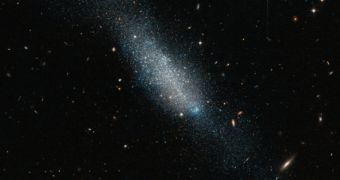Usually, galaxies are divided into two main categories, spiral or elliptical. The former category includes the Milky Way and most other galaxies in the Universe, whereas the latter contain the largest cosmic formations ever discovered. When our galaxy collides with Andromeda, in about 2 billion years, these two spiral galaxies will form a massive elliptical galaxy.
Though it is generally easy to tell these galaxies apart, astronomers do tend to encounter weird galactic shapes from time to time, which defy conventional classification. Such is the case with the object depicted in the image above, which is known as ESO 149-3.
This structure represents a fine example of what astronomers term an irregular galaxy. This means that it has no discernible shape of inner structure, but rather that it resembles a large, floating cluster of stars. According to statistics, around 25 percent of all galaxies in the Cosmos are irregularly shaped.
This image, taken with the NASA/ESA Hubble Space Telescope (HST), reveals no inner structure, core or arms associated with ESO 149-3. Though the photo is focused on this object, multiple other galaxies can be easily seen in the background, as smudges in Hubble's field of view.

 14 DAY TRIAL //
14 DAY TRIAL //